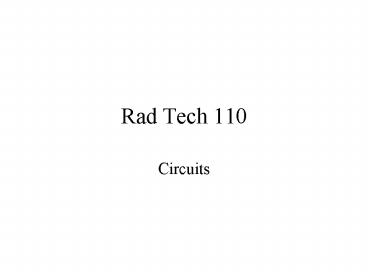Rad Tech 110 - PowerPoint PPT Presentation
1 / 29
Title:
Rad Tech 110
Description:
Both voltage and current In a step-up transformer the voltage is increased The primary side (incoming) has less coils than the secondary (outgoing) side. – PowerPoint PPT presentation
Number of Views:21
Avg rating:3.0/5.0
Title: Rad Tech 110
1
Rad Tech 110
- Circuits
2
Conditions Necessary X-ray Production
- High voltage
- In the kilovoltage range
- Electrons
- A supply of electrons
- A need to stop the electrons suddenly
3
Types of Transformers
Shell type
Core type
4
How do transformers work?
- They can only work using AC current
- On the principle of induction
- Mutual
- Self
- The basic premise is that AC current induces
alternating magnetic fields.
5
Transformers work?
- These alternating magnetic fields are distributed
throughout the core of the transformer. - The alternating magnetic fields induce an
electrical current in loops (coils) of wire.
6
(No Transcript)
7
What gets transformed?
- Both voltage and current
- In a step-up transformer the voltage is increased
- The primary side (incoming) has less coils than
the secondary (outgoing) side. - Because there are more coils on the secondary
side a higher voltage is produced - Increases voltage is reflected as a higher
amplitude of the waveform.
8
- At the same time as voltage increases the current
correspondingly decreases. - This occurs due to the conservation of energy.
- If you increase one aspect, voltage, you have to
decrease the other, current. - (Voltagep)(currentp)(voltages)(currents)
9
Step down transformer
- Here the primary side has more coils than the
secondary side. - The result is a decrease in voltage through the
transformer.
10
The X-ray Circuit
11
Three sections of the x-ray circuit
- Operating (control) console
- High voltage generator
- X-ray tube
12
Operating (control) console
- Line voltage compensator
- Autotransformer
- kVp selector
- mA selector
- Timer
- Pre-reading kVp meter
13
Line voltage compensator
The purpose of the line voltage compensator is to
maintain a constant voltage to the system. In the
modern system this is done automatically.
14
Autotransformer
The autotransformer works on the principle of
self-induction. It has a single core and is
responsible for varying the voltage. Because of
its ability to adjust voltage, the
autotransformer can be either a step-up or
step-down transformer.
15
kVp selector
- kVp is adjusted at the autotransformer
- Taps are available so that different voltages can
be achieved.
16
Pre-reading kVp meter
- The kVp meter is considered pre-reading because
it is not actually measuring kVp but measuring
voltage off the autotransformer. - Remember, the autotransformer is used to adjust
voltage.
17
Timer
- Historically, there have been many types of
timers. - Today, all timers are electronic timers of
various types. - mAs
- Phototiming (AEC)
- Regular electronic
18
mA selector
- Allows for adjust of the filament voltage
- Precision resistors
- Choke coil
19
High Voltage Generator
- Step-up transformer
- High voltage transformer
- High tension transformer
- Step-down transformer
- Filament transformer
- Rectifiers
20
Step-up Transformer
- This transformer is responsible for producing the
high voltages necessary for x-ray production. - Turns ratio of 5001 or 10001
21
Filament Transformer
- Intended to lower voltage and increase current
- Allows for thermionic emission to occur at the
filament - Ultimately, provides the electrons necessary for
x-ray production. - Tube current measured in mA.
22
Rectifiers
- Current traffic cops
- Intended to allow electrons to flow in only one
direction - Provide the mechanism that converts AC to DC
current. - 4 rectifiers are required to fully convert AC to
DC.
23
Types of Circuits
- Single phase
- Full wave
- Half wave
- Three phase
- 6 pulse
- 12 pulse
- Medium and High Frequency
- Capacitor discharge
- Found predominantly in portables.
24
Single Phase
- Full
- Half
25
Three phase
- 6 pulse
- 12 pulse
26
Three phase transformers
- Three phase units use delta and wye
transformers - 6 pulse
- 2 wye and 1 delta
- 12 pulse
- 2 delta and 1 wye
- They also require 12 rectifiers
27
Advantages of 3 phase
- Higher beam quantity and quality
- Higher mA stations are also possible
28
Why higher quantity and quality for three phase?
- Because the voltage ripple is less
- Basically when the tube is energized it stays
energized.
full
3 phase 12 pulse
29
Medium/High Frequency Generator

